Related Research Articles
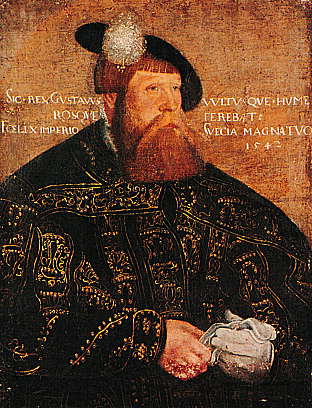
Gustav I, born Gustav Eriksson of the Vasa noble family and later known as Gustav Vasa, was King of Sweden from 1523 until his death in 1560, previously self-recognised Protector of the Realm (Riksföreståndare) from 1521, during the ongoing Swedish War of Liberation against King Christian II of Denmark, Norway and Sweden. Gustav rose to lead the Swedish War of Liberation following the Stockholm Bloodbath, where his father was executed. Gustav's election as king on 6 June 1523 and his triumphant entry into Stockholm eleven days later marked Sweden's final secession from the Kalmar Union.

Sigismund III Vasa was King of Poland and Grand Duke of Lithuania from 1587 to 1632 and, as Sigismund, King of Sweden and Grand Duke of Finland from 1592 to 1599. He was the first Polish sovereign from the House of Vasa. Religiously zealous, he imposed Roman Catholicism across the vast realm, and his crusades against neighbouring states marked Poland's largest territorial expansion. As an enlightened despot, he presided over an era of prosperity and achievement, further distinguished by the transfer of the country's capital from Kraków to Warsaw.

Charles IX, also Carl, reigned as King of Sweden from 1604 until his death. He was the youngest son of King Gustav I and of his second wife, Margaret Leijonhufvud, the brother of King Eric XIV and of King John III, and the uncle of Sigismund, who became king both of Sweden and of Poland. By his father's will Charles received, by way of appanage, the Duchy of Södermanland, which included the provinces of Närke and Värmland; but he did not come into actual possession of them till after the fall of Eric and the succession to the throne of John in 1569.

John III was King of Sweden from 1569 until his death. He was the son of King Gustav I of Sweden and his second wife Margaret Leijonhufvud. He was also, quite autonomously, the ruler of Finland, as Duke John from 1556 to 1563. In 1581 he assumed also the title Grand Prince of Finland. He attained the Swedish throne after a rebellion against his half-brother Eric XIV. He is mainly remembered for his attempts to close the gap between the newly established Lutheran Church of Sweden and the Catholic Church, as well as his conflict with and murder of his brother.

The monarchy of Sweden is centered on the monarchical head of state of Sweden, which is a constitutional and hereditary monarchy with a parliamentary system. There have been kings in what now is the Kingdom of Sweden for more than a millennium. Originally an elective monarchy, it became a hereditary monarchy in the 16th century during the reign of Gustav Vasa, though virtually all monarchs before that belonged to a limited and small number of families which are considered to be the royal dynasties of Sweden.
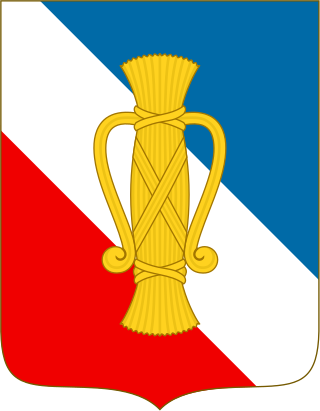
The House of Vasa or Wasa was an early modern royal house founded in 1523 in Sweden. Its members ruled the Kingdom of Sweden from 1523 to 1654 and the Polish–Lithuanian Commonwealth from 1587 to 1668. Its agnatic line became extinct with the death of King John II Casimir of Poland in 1672.

The Early Vasa era is a period that in Swedish and Finnish history lasted between 1523–1611. It began with the reconquest of Stockholm by Gustav Vasa and his men from the Danes in 1523, which was triggered by the event known as the Stockholm Bloodbath in 1520, and then was followed up by Sweden's secession from the Kalmar Union, and continued with the reign of Gustav's sons Eric XIV, John III, John's son Sigismund, and finally Gustav's youngest son Charles IX. The era was followed by a period commonly referred to as the Swedish Empire, or Stormaktstiden in Swedish, which means "Era Of Great Power".

During the 17th century, despite having scarcely more than 1 million inhabitants, Sweden emerged to have greater foreign influence, after winning wars against Denmark–Norway, the Holy Roman Empire, Russia, and the Polish–Lithuanian Commonwealth. Its contributions during the Thirty Years' War under Gustavus Adolphus helped determine the political, as well as the religious, balance of power in Europe.
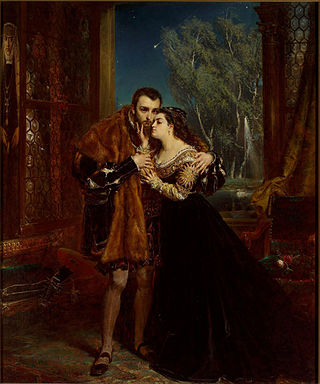
The Polish Golden Age was the Renaissance period in Poland and the Grand Duchy of Lithuania, roughly corresponding to the period of rule of the King Sigismund I the Old and his son, Sigismund II Augustus, the last of the Jagiellonian Dynasty monarchs, until his death in 1572. Some historians reckon the Polish Golden Age to have continued to the mid-17th century, when the Polish–Lithuanian Commonwealth was ravaged by the Khmelnytsky Uprising (1648–57) and by the Swedish and Russian invasion. During its Golden Age, the Commonwealth became one of the largest kingdoms of Europe, stretching from modern Estonia in the north to Moldavia in the east and Bohemia in the west.
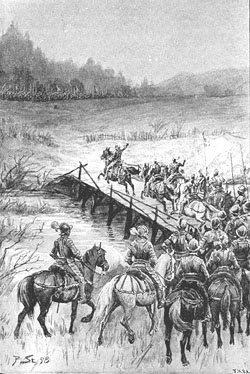
The Battle of Stångebro, or the Battle of Linköping, took place at Linköping, Sweden, on 25 September 1598 (O.S.) and effectively ended the personal union between Sweden and the Polish–Lithuanian Commonwealth, that had existed since 1592. In the battle, an army of c. 8,000–12,000 commanded by Duke Charles defeated a mixed force of c. 5,000–8,000 consisting of an invading army of mercenaries in the king's employ and diverse but poorly co-ordinated supporting Swedish noblemen's forces commanded by King of both Sweden and the Polish–Lithuanian Commonwealth Sigismund III Vasa, who was acting to maintain and restore his personal union against anti-Catholic forces in Lutheran Sweden. The Swedish king's general Constantin fought at the western bridge.
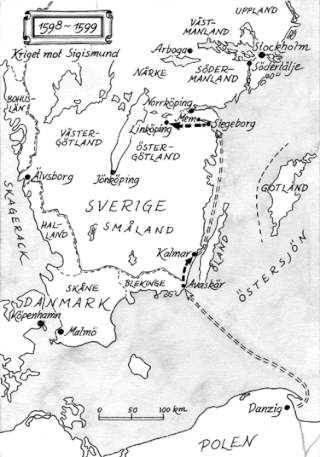
The war against Sigismund was a war between Duke Charles, later known as King Charles IX of Sweden, and Sigismund, who was at the time the king of both Sweden and the Polish–Lithuanian Commonwealth. Lasting from 1598 to 1599, it is also called the War of Deposition against Sigismund, since the focus of the conflict was the attempt to depose the latter from the throne of Sweden. The war eventually resulted in the deposition of Sigismund, the dissolution of the Polish-Swedish Union, and the beginning of an eleven-year war.
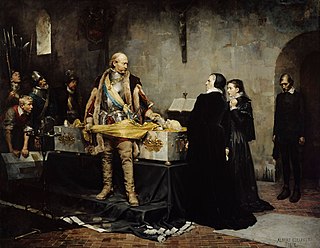
Baron Klaus Eriksson Fleming was a Finnish-born member of the Swedish nobility and admiral, who played an important role in Finnish and Swedish history during the rise of Sweden as a Great Power. He was a trustee of kings John III and Sigismund Vasa. His wife was Ebba Stenbock.

Anna Vasa of Sweden was a Polish and Swedish princess, starosta of Brodnica and Golub. She was the youngest child of King John III of Sweden and Catherine Jagiellon. She was close to her brother Sigismund Vasa, King of Poland (1587–1632) and King of Sweden (1592–99). Raised a Catholic, Anna converted to Lutheranism in 1584 which made her an ineligible bride for many of Europe's Catholic royals and she remained unmarried.

The Polish–Swedish union was a short-lived personal union between the Polish–Lithuanian Commonwealth and the Kingdom of Sweden between 1592 and 1599. It began when Sigismund III Vasa, elected King of Poland and Grand Duke of Lithuania, was crowned King of Sweden following the death of his father John III. The union ended following a civil war in Sweden in which he lost the crown to his uncle, who eventually became Charles IX. Sigismund afterwards returned to Warsaw and pursued a war against his former realm.

The Linköping Bloodbath on 20 March 1600 was the public execution by beheading of five Swedish nobles in the aftermath of the War against Sigismund (1598–1599), which resulted in the de facto deposition of the Polish and Swedish King Sigismund III Vasa as king of Sweden. The five were advisors to Catholic Sigismund or political opponents of the latter's uncle and adversary, the Swedish regent Duke Charles.

Ebba Gustavsdotter Stenbock was a Swedish noble. She led the defense of the stronghold Turku Castle for the loyalist of Sigismund III Vasa during the Siege by Charles IX of Sweden in succession of her spouse Clas Eriksson Fleming (1530–1597), governor of Finland. The sister of queen Katarina Stenbock, she married Clas Eriksson Fleming (1530–1597), governor of Finland, in 1573.
The Åbo Bloodbath of 10 November 1599 was a public execution in the Finnish town of Turku (Åbo), then part of the Kingdom of Sweden, in the context of the War against Sigismund and the Club War. Sweden was by then in the final phase of a civil war, with one faction supporting king Sigismund III Vasa, who also was king and Grand Duke of Poland–Lithuania, and another faction supporting duke Charles of Södermanland, the later Charles IX, Sigismund's paternal uncle. After winning the upper hand in the dispute, Charles crushed the last resistance to his rule, particularly in Finland, while Sigismund had already retreated to Poland.
Arvid Stålarm, actually Arvid Eriksson (Stålarm) till Lindö i Tenala was a Swedish noble and soldier from the Finland-based Stålarm family. He is sometimes called "the Younger" to distinguish him from his grandfather and namesake who died in 1529.
Margareta Brahe was a Swedish courtier; hovmästarinna to princess Anna Vasa of Sweden, from 1591.

The Kalmar Bloodbath, sometimes described as the Second Kalmar Bloodbath to distinguish it from an earlier massacre in the same place, was the public mass execution of 22 men in Kalmar, Sweden, on 16 May 1599. All of the victims were members of the garrison from Kalmar Castle, and included three noblemen and a priest, all four of whom were beheaded. The other eighteen victims, comprising secretaries, garrison officers and mercenary commanders, were all hanged.
References
- ↑ "Archived copy". Archived from the original on 2016-09-12. Retrieved 2018-10-08.
{{cite web}}: CS1 maint: archived copy as title (link) - ↑ "Archived copy". Archived from the original on 2016-09-12. Retrieved 2018-10-08.
{{cite web}}: CS1 maint: archived copy as title (link)